Local Scouts Discover Chemistry is Fun!
June 12, 2012
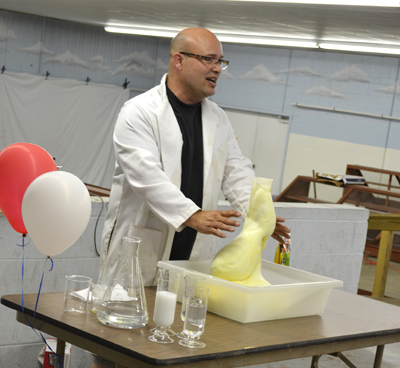
Jesse Miller performs a demonstration with hydrdogen peroxide and soap.
Although they had just recently gotten out of school, local Cub Scout Pack 402, as well as some area girl scouts, took time out in the midst of a fun-filled week at a Cub Scout Day Camp to do something just as fun—learn about chemistry.
Like a magician pulling rabbits out of a hat, Jesse Miller from Illinois' Department of Chemistry pulled one trick after another out of his bag of chemistry magic tricks. One of the principles he pulled from his bag was to demonstrate that, because Helium is less dense than air, the speed of the sound of one's voice is much higher in helium. Taking a swig from a helium-filled balloon, his voice took on that "Alvin-and-the-chipmunks" quality we all are familiar with, having performed that experiment at some birthday party during our childhood. The young people laughed even more when, after breathing in a heavier-than-air gas from a Sulfur-Hexafluoride-filled balloon, he bellowed out a Darth Vadar imitation.
For another trick in his magic act, Miller added soap to Hydrogen Peroxide (see photo above), producing a volcano-like eruption of bubbles. (For chemistry buffs, this was caused by the rapid decomposition of Hydrogen Peroxide into oxygen gas and steam when catalyzed by Potassium Iodide.)
At one point, he sent an electric current into an ordinary pickle; the electricity excited the electrons in the sodium atoms, causing the pickle to glow with a yellow light. He explained that fireworks work the same way, causing different metals to glow with different colors.
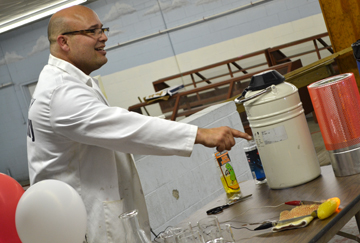
Miller points to a pickle he has made to glow by sending an electric charge into it.

Cub scout examines a rubber ball fragment.
Miller did a lot with liquid nitrogen. At one point, he poured it into his hand, explaining to the kids that it wouldn't hurt him because as soon as the nitrogen came into contact with his skin, it boiled off and formed a thin protective layer of gas that kept the liquid off. However, he explained that holding it in his hand or submersing his hand in the nitrogen would be harmful and freeze his hand. To illustrate how cold liquid nitrogen is, after showing off his juggling skills with several rubber racket balls, he immersed them in liquid nitrogen. When he dropped the quick-frozen balls on the floor, they shattered into fragments. Once the pieces were warm enough to touch again, the kids passed them around, most likely taking them home as souvenirs.
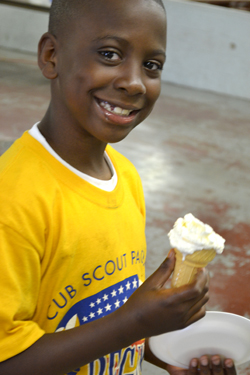
Cub scout enjoying his ice cream.
However, the pièce de résistance of the entire presentation, and what many of the youth had been looking forward to since last year's show, was the ice cream. But this wasn't ordinary ice cream. Miller, who had drafted his son Alex to do the stirring, whipped up some delicious, made-from-scratch ice cream with some wholesome ingredients like sugar, heavy cream, strawberries, and…liquid nitrogen. Explaining that it wasn't harmful (there's nitrogen in the air we breathe), like some mad scientist, the elder Miller poured in the nitrogen, which condensed into a creeping cloud of thick fog like from Twilight, while the younger Miller stirred. The kids watched in anticipation as the nitrogen slowly froze the ingredients, turning them into ice cream, which everyone (including me) sampled, and declared quite tasty. During the ice-cream-tasting portion, I asked one of the youngsters what was his favorite part of the show. His mouth full, with a big grin, he politely pointed to the ice cream in his cone. I think that says it all.
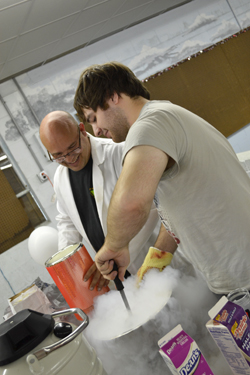
The Millers use liquid nitrogen to make ice-cream.
During the chemistry show, Miller was clearly enjoying himself, and obviously does something of this nature often enough to have developed a well-rehearsed routine. When asked why he takes time out of his schedule to do chemistry shows, Miller replied, "I just love doing it. I started years ago with my own kids and nieces and nephews at family gatherings. It just kind of grew from there. I have a regular spot on WCIA's morning show on Wednesday mornings, too. Kids eat this stuff up. And even though they may or may not understand the concepts behind the demonstrations, they find it fun and interesting."
During the chemistry show, the kids appeared to be engaged; Miller said that's something he encourages throughout the presentation:
"I ask a lot of questions in the show to try to keep them directly engaged. It doesn't really matter if they are right. It is the process of being inquisitive, and that is what science is all about."
When asked why the chemistry department does these kinds of outreach, and whether it's a sort of long-term recruitment, Miller replied that the department considers it a part of giving back to the community:
"The department doesn't really have an outreach program, but they support those of us who do this on our own. I think the department (and school) look at it as giving back to the community. If the kids become interested in science and have good feelings for the University, perhaps they will choose to come here. But that's a pretty small if. I think the entire community benefits from having a strong science outreach which also, ultimately, benefits the University."
Whether or not the young people who sat in on Miller's chemistry show experienced career-deciding epiphanies and ultimately end up studying at Illinois to become scientists, there's one thing that they undoubtedly got out of the afternoon's event: chemistry can be fun!
Story and photos by: Betsy Innes, Communications Specialist, I-STEM Education Initiative
More: K-6 Outreach, Chemistry, Champaign-Urbana Community, 2012
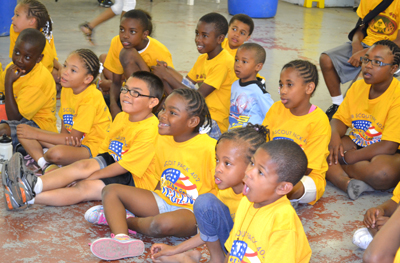
Youngsters enjoying the chemistry presentation.













.jpg)
















